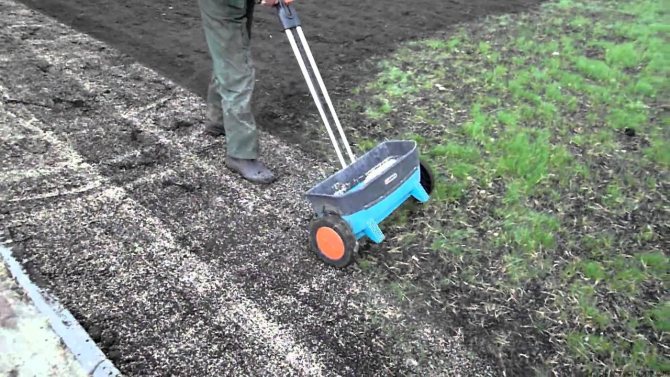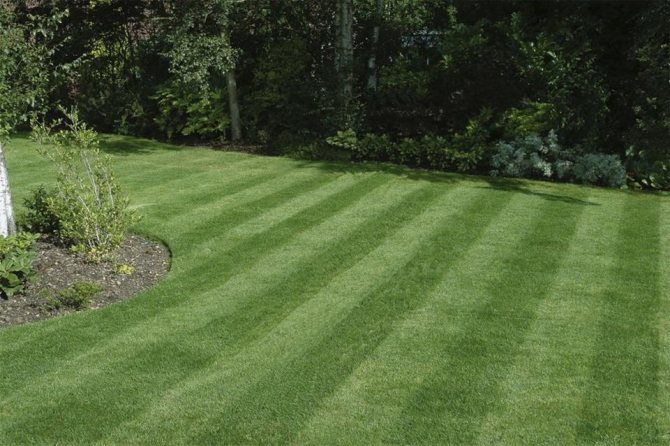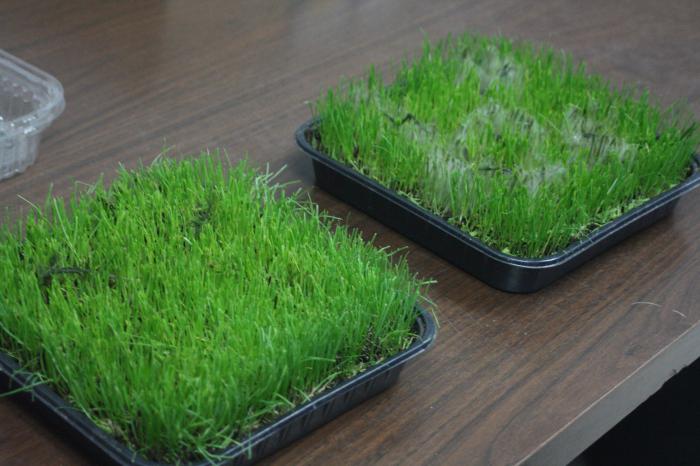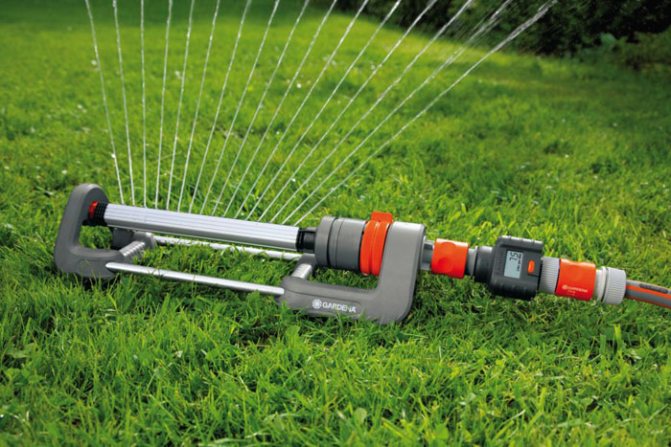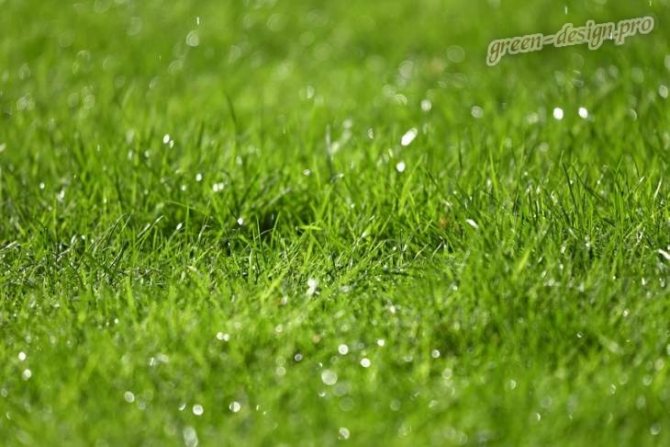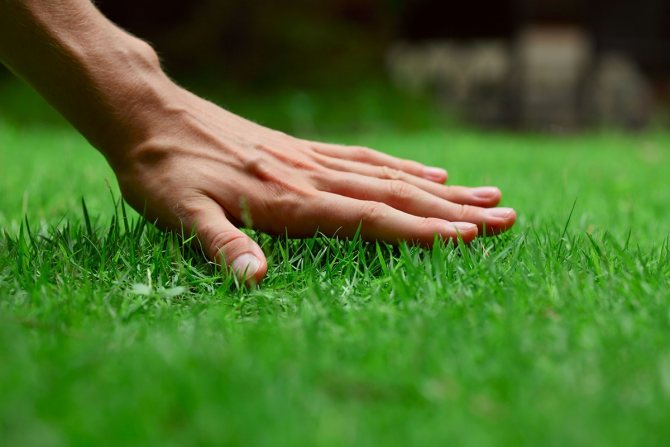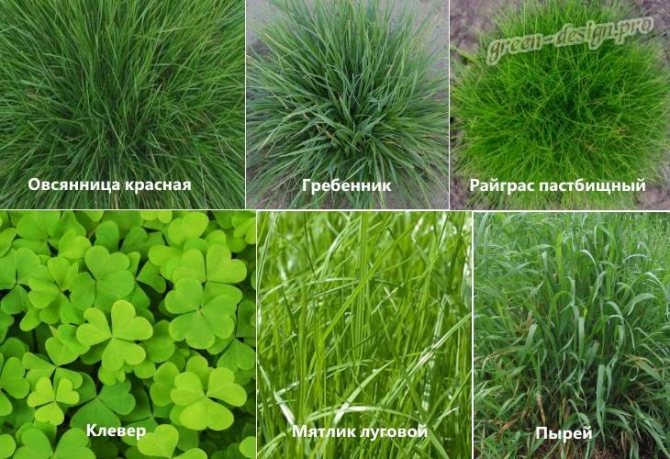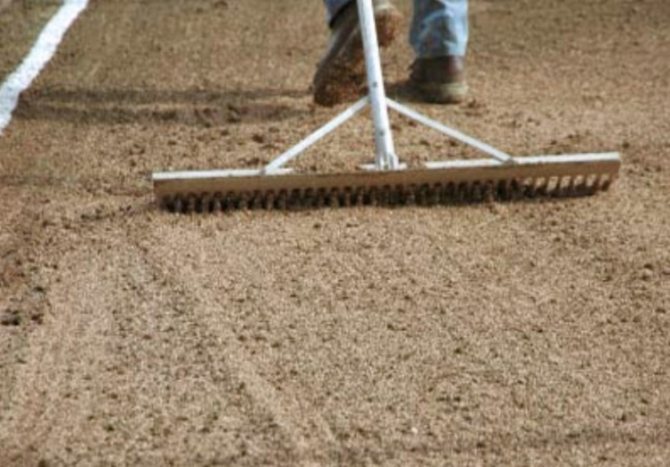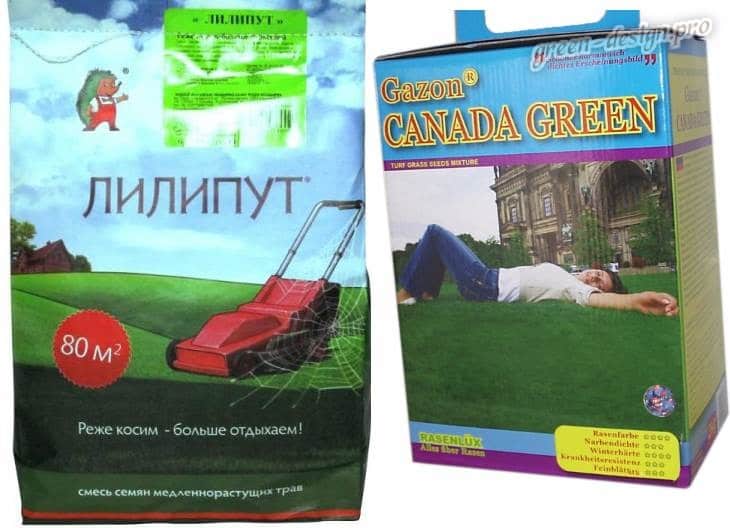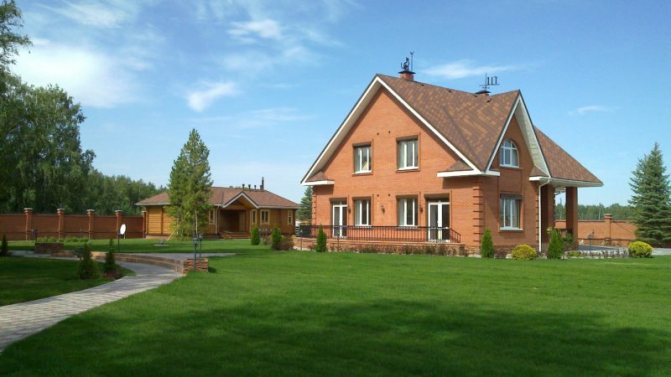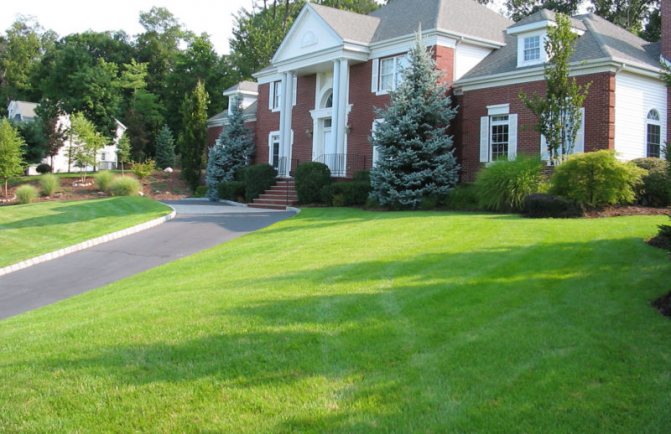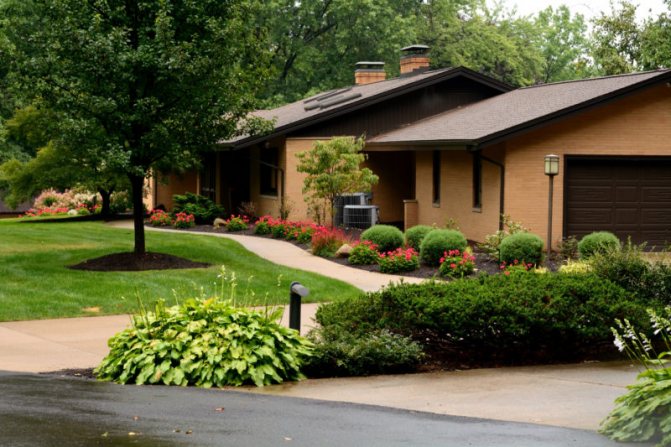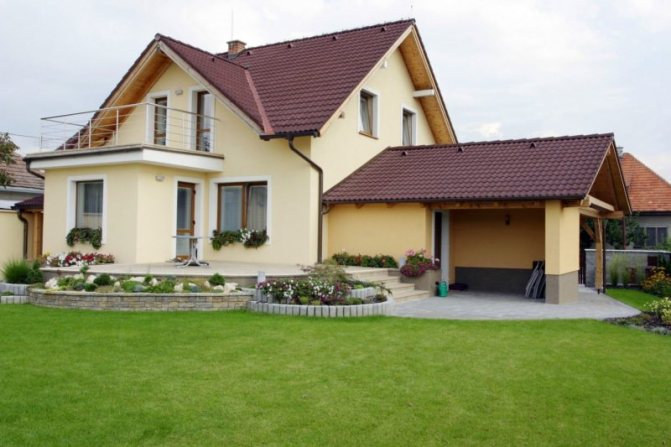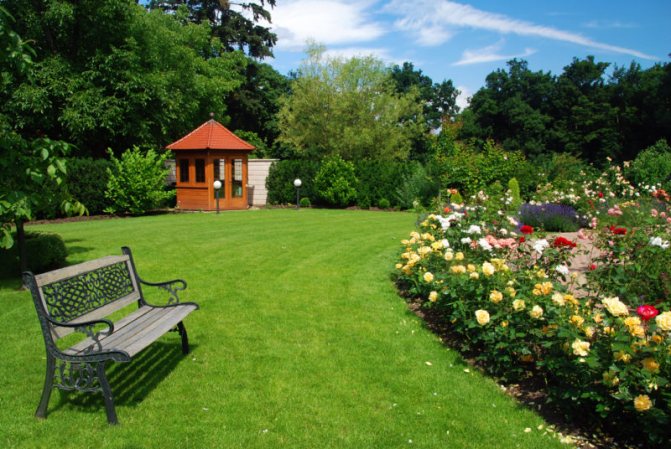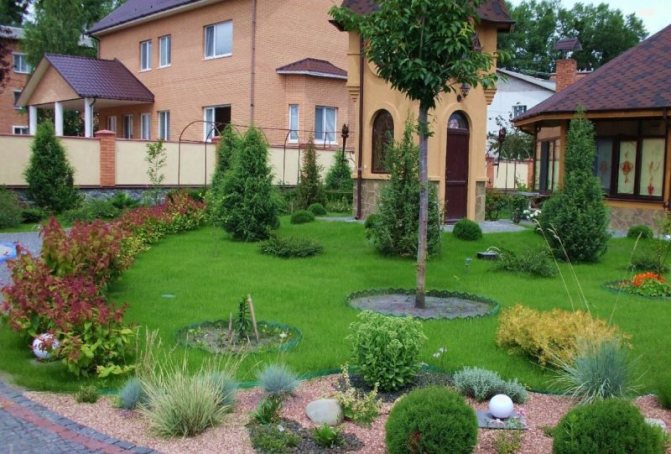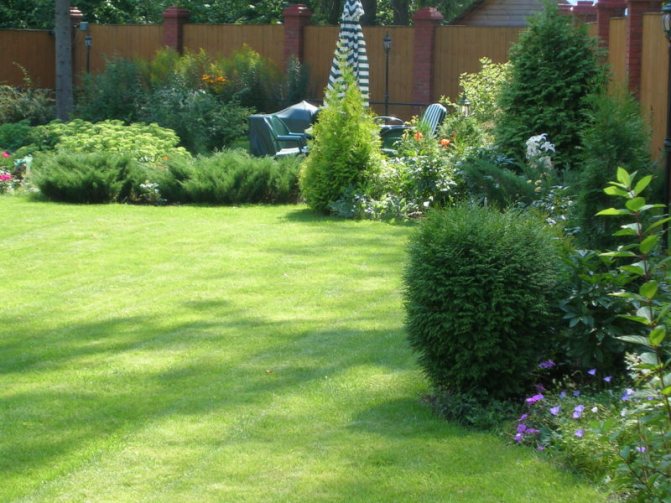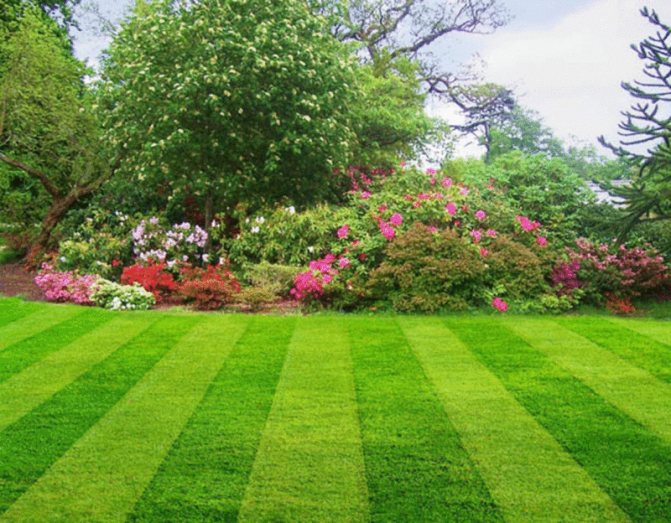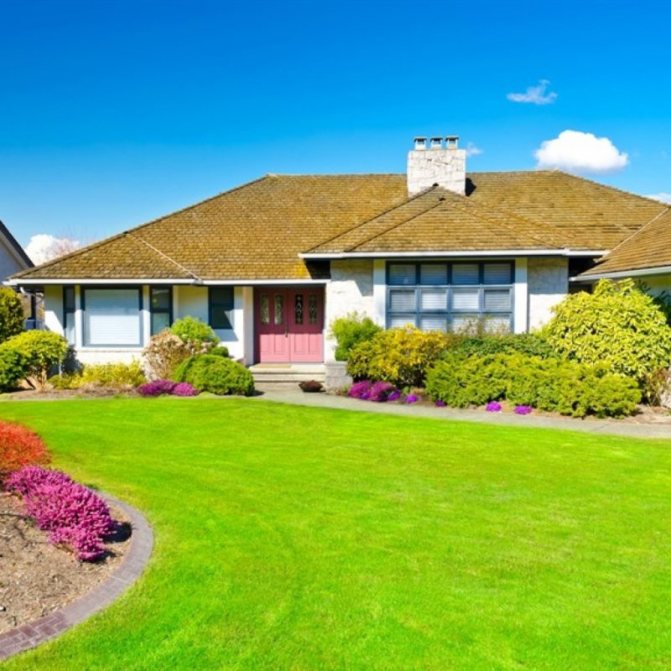Fantasies about a green well-groomed lawn can only be realized in the country or by changing a city apartment for a country house.
If everything is all right with you, then you can start looking for answers to questions regarding the purpose of the lawn, based on which already, choose the lawn itself.
- Parterre
... Consists of elite herbal varieties, mostly native to Canada; - Mauritanian
.Formed by annual flowering plants, planted in open areas and places where cultivated plants cannot grow; - Lugovoi
... Similar to Moorish, except that it is planted in park areas; - Ordinary
. Formed from domestic herbs with strong stems and a stable root system.
Planting and caring for each of the listed lawns has its own characteristics.
Taking into account the fact that the planting of an ordinary lawn is most often practiced, by its example we will consider the features of planting grass with our own hands.
Stages of preparation of the landing site
Before you start planting an ordinary lawn, you need to do a number of preparatory work.
The first is the choice of a place for the lawn
Be sure to think about how the lawn will blend with the rest of the garden.
At this stage, it is important to determine where the lawn planting will take place with the measurement of the area. This is important in order to determine the number of seeds, fertilizer and soil needed to plant the lawn.
When choosing a place for a lawn, it is important to think about the site being linked to the rest of the garden with strict adherence to boundaries, preventing lawn grass from spreading to flower beds, shrubs on the site.
The level of the lawn must be higher than the level of the path or court. It is important to leave a 10 cm wide strip of gravel or sand between the retaining wall and the lawn to prevent damage to the mower during mowing.
The second is the preparation of the site
At the site where the lawn will be planted, all construction work must be completed, laid is a prerequisite for areas with high humidity.
The technology of laying drainage implies the removal of the top layer of soil with laying on an infertile soil layer of gravel, broken brick or stone in a layer of 10-15 cm, then a layer of sand and fertile soil in layers of the same thickness, followed by compaction with a roller.
A prerequisite is cleaning garbage from the territory, removing weeds with rhizomes.
On particularly large areas, a herbicide can be used to remove weeds with strict adherence to safety regulations.
It is important to take into account that in order for the drug to work, you will need to wait a few weeks and only then begin to prepare the fertile layer.
We create.
Want to plant a cotoneaster in your garden? we have an article about him.
Third - preparation of the fertile layer
The lawn roller makes it easier to tamp the soil
Mixing of the potting mix is done by hand in small areas and using specialized techniques in large areas. It is important to remove dead parts of herbicide treated plants and root systems.
Large clods of earth are broken with a shovel, after which they pass across the entire territory in a criss-cross pattern with a garden rake.
At this stage, it is important to take care of leveling the soil: filling holes, removing bumps. Uneven soil will eventually lead to defects during lawn mowing and breakage of the mower legs.
For leveling the soil, a roller is most often used. With its help, you can almost perfectly level the soil, if necessary, the procedure is carried out several times.
The ideal option is to leave the prepared soil alone for a few months for fallowing. During this time, natural shrinkage will occur, as a result of which it will be possible to determine all the surface irregularities.
In addition, in this case, it will be possible to remove newly appeared weeds on the prepared soil, which will help facilitate future lawn care.
Step-by-step instructions for sowing a lawn in autumn
After building a house and improving the local area, you can devote time to the lawn. In order for the process to go well, and in the spring the green cover is pleasing to the eye, it is necessary to take into account the rules that will make this process easier and more effective. The selection of seeds, preparation of soil, fertilizers are important steps, the observance of which will allow you to decorate the site for a long time.
Dates of autumn planting
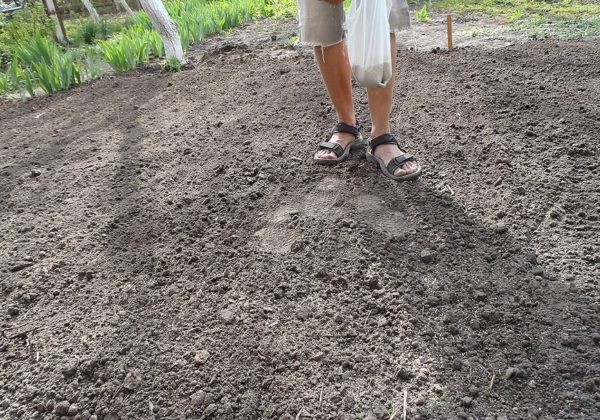
In the fall, it is possible to sow seeds twice - in late August, early September, or in October, early November. In the first case, it is important to take into account that at least 40-45 days must elapse between the disembarkation period and the onset of frost. In this case, a strong root system will have time to form, and the aerial part will grow up to 10 cm. Sudden night frosts can destroy crops, so it is better not to postpone this process, starting a little earlier.
Before winter, sowing in late October, early November, it is possible even in frozen soil. In this case, the seeds will undergo a natural process of stratification, which makes it possible to grow active and friendly seedlings in the spring. So that the seed does not die, it is worth considering the planting time when choosing grass varieties. There are also risks - if, after sowing, warm weather suddenly returns with temperatures above + 5 ° C, the germination period will begin, as a result of which the seedlings will die from the cold.
Site preparation
Before sowing, the land must be properly prepared so that as a result, a beautiful green carpet flaunts in front of the house. The first step is to completely clear the area of everything that might interfere:
- construction garbage;
- stones that cannot be entered as an addition or an island;
- branches;
- old stumps;
- dry bushes, trees.
On a site where nothing has been planted for a long time, or is being cultivated for the first time, it is better to treat the soil with herbicides. Then, when sprouting, minimal weeding is required.
When the place is cleared, processed, it is necessary to start digging in order to remove the small roots of plants, the remaining debris. It is better to lighten clayey viscous soil - for this, fine gravel or sand is introduced, then aeration will be better. Compost or humus is added to the sandy soil. For good growth of lawn grasses, the optimum acidity is 5.5-7 pH, if it is higher, liming is carried out with lime or dolomite flour.
In areas with high humidity, it is better to arrange drainage:
- Remove the top layer of the soil.
- Stones, broken brick, pebbles are poured on top, in a layer of 15-20 cm.
- Lay a layer of sand 8-10 cm thick.
- The surface is leveled, tamped with a special roller or a thick log.
- The removed fertile layer is returned to its place.
For sedimentation of the soil, 10-15 days are allocated, after which the territory is again leveled, filling in the pits, equalizing the bumps. Now you can apply fertilizers with potassium and phosphorus, or special mixtures for lawns. The granules are properly mixed with the soil using a rake, leveling around the entire perimeter.At the end, it is tamped again with a roller or a thick log, and watered abundantly for additional stabilization.
Methods for ramming the land on the site
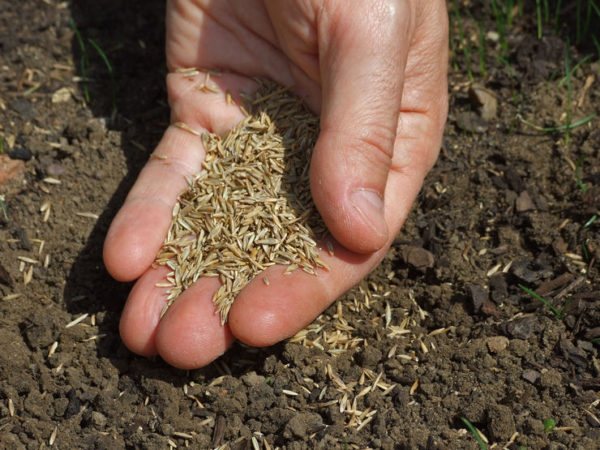

After the soil has been leveled, it must be tamped down so that the layer is smoother during germination, and during mowing the lawnmower does not "stumble" over irregularities, breaking the knives. On an unpaved lawn, the sown grass will be pulled out by the roots during the first mowing. The area is leveled with a vibrating plate or a special roller, until there are no traces left when walking. Not everyone is ready to spend money on the purchase of additional equipment, which, perhaps, will be used once, so sometimes other devices are used:
- a wide board or log, with ropes tied at the ends;
- a barrel filled with water 1/4;
- boards tied to feet or slippers;
- concrete ring.
Read also Hydrangea petiolate photo and description
Treatment of the site with herbicides
There are many different drugs on the shelves of shops for gardeners, so when choosing, questions arise - which ones to choose and how to use them correctly so as not to harm the plantings. To maintain a beautiful lawn, it is necessary to regularly weed or treat with herbicides, and in order for the weeds to initially grow less, the processing process must be started even before sowing. The soil is treated with herbicide and left for 1.5-2 weeks, after which it is leveled and started to plant.
Before using the product, you must carefully read the instructions, observe the recommended concentration. Do not add a little more - "in reserve" or for better effect, this can lead to the fact that the concentration in the soil will be too high, and it will not be possible to plant anything on it for several years.
Follow safety rules so as not to get chemical burns, allergies, irritation. To do this, you need to work with gloves and, possibly, a respirator (depending on the drug and its composition).
In order not to buy a useless or low-quality product, try to follow the recommendations of your friends or colleagues.
Fertilization and soil preparation for the lawn
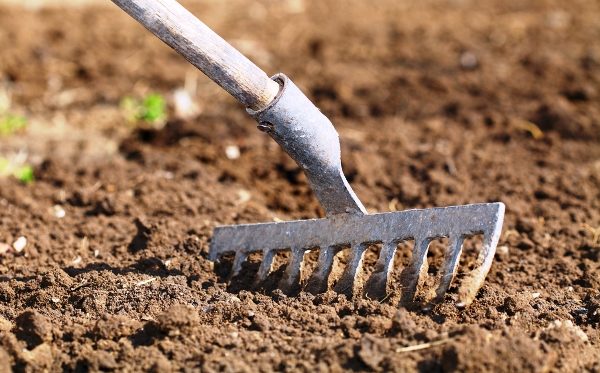

Fertilizers are best added before sowing, then the minerals in the prepared soil will ensure rapid growth and development of shoots. A complex of trace elements from ammonium nitrate, superphosphate and potassium sulfate is applied in bulk, evenly distributing over the entire surface, excluding heaps of accumulations in one place. Magnesium and boron are diluted in water and watered. From organic fertilizers, dry chicken manure is used, mixed with wood ash (potassium) and peat.
How to properly spread seeds
Can you plant in the rain? It is better to sow in dry weather without wind, then the grass will take root well. On the eve, the top layer is watered abundantly. Seed material is mixed with sand in a 1: 1 ratio, scattered around the entire perimeter, first along, then across. After applying the seeds, the soil is loosened superficially with a rake, and then lightly tamped with a roller, a thin layer of black soil or peat is applied for mulching. At the end, be sure to watered with a fine sprinkler.
It is better to sow by hand only in small areas and with experience, otherwise the seeding density will be uneven. A manual or mechanical seeder can be used. For large areas and slopes, another method is suitable - hydroseeding. To do this, create a composition of several components - a hydrogel (to maintain the moisture level), fertilizers, colored mulch (visually shows where the insufficient seed layer is). This mixture is introduced using a hydraulic seeder. Saplings planted in this way are not afraid of melt water and strong winds.
Planting lawn grass
The best time to plant a lawn is autumn. During this period, there is a sufficient amount of dew and rain, so there will be no need for frequent watering.
The ideal option is early September.
- Lawn grass seeds should be scattered over the prepared soil with light, short hand movements.
- It would be best to divide the seeds into two parts and sow the first part along the lawn, and the second across.
- You can sow thickly, in this case, the formation of sod will occur faster, but at the same time observe the measure, not exceeding the permissible rate by half, since in this case the grass bushes will be closely together and they will often hurt.
- When the seeds are sown, it is necessary, using a cultivator or a simple rake, to mix them with the soil in order to protect them from birds.
An alternative to this method of protection will be the peat layer, which will also create suitable conditions for seed germination. The final stage of sowing will be the compaction of the soil with a roller.
If the weather conditions are favorable, the first shoots can be expected in 10 days.
Do not be alarmed if the seedlings are uneven, this is normal, as bushes can germinate at different rates.
You should wait at least another 20 days in order to assess the situation and determine the need for additional sowing of the seeds. Remember that young shoots of lawn grass are very tender, so at first it is better not to walk on it.
Varieties of lawns
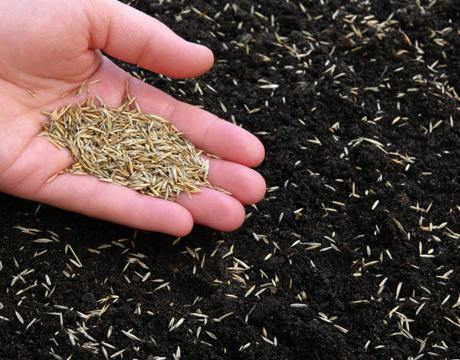

First, let's figure out how you can decorate your garden. There are these types of lawns:
- Lugovoi. It consists of flowering annuals and is grown in parks.
- Parterre. For its planting, grass varieties are used that are considered elite.
- Ordinary. To grow such a lawn, cheaper seeds are used, while the grass must have a strong root system and stem in order to be able to grow in difficult climatic conditions.
- Moorish. It is similar to meadow, only it can be planted only where cultivated plants are not sown.
Lawn Grass Care
When the lawn takes root, it will be left to "little" - to take care of its health and appearance, regardless of the season and weather. Care includes several stages, each of which is described in more detail below.
Weeding the lawn
The first weeding is carried out a few weeks after sowing the lawn, while the roots of the weeds are underdeveloped.
Perennial weeds are dug up together with the roots, the most "tenacious" of them are removed with a knife or a narrow shovel.
It is difficult and time-consuming to manually weed, but this is the most effective method. After the end of manual weeding, the soil with lawn grass is compacted and moistened.
Lawn mowing
Rotary Lawn Mower Blades
A rooted lawn simply needs to be refined with a mowing, which is also an effective method for weed control by buying or renting a lawn mower.
When choosing a lawn mower, it is important to take into account the size of the plot, the presence (absence) of a grass catcher.
The most accurate cut is obtained with a rotary lawnmower.
Cylindrical lawn mowers are suitable for maintaining flat lawns, while tractor and gas-powered lawn mowers are ideal for large areas.
Remember that you need to change the cutting vector regularly, as constant cutting in one direction will tamp the bud too much, as a result of which the grass will grow at an angle.
Edges with overseeding of the lawn
Lawn edges cannot be mowed with a lawn mower.
It will be possible to refine them using scissors or an electric trimmer - a device for processing edges.
To change the shape of the edges, you can use a sickle; to restore the damaged area, you will need to cut out a part of the damaged turf, and then unfold it in a defective area towards the center of the lawn.
Lawn leveling
Recesses formed in the lawn can be easily leveled with the help of a filler consisting of sand and garden soil.
For leveling, the mixture is distributed over the site with a shovel, after which it is leveled with the back of the garden rake to obtain a layer no more than 1 cm thick.
After the procedure, the grass will need to be delicately cleaned with a broom.
What is the best way to apply it on the site?
We select ornamental shrubs.
Top dressing: fertilizer for lawn areas


TerraSol is one of the brands of lawn fertilizers
The ever-green and bright grass on the lawn will remain throughout the season only if it receives a full range of fertilizers. In the spring, you can feed the grass with nitrogen fertilizers for growth, in the fall - with a phosphorus-potassium autumn mixture of fertilizers to prepare for winter.
Small lawn areas are fertilized manually with granular fertilizers and using a watering can if using liquid fertilizers.
For large areas, it is better to use wheel sprayers and granular fertilizers.
Note!
You need to fertilize the soil only in dry weather, while the soil should not be too dry, therefore, if necessary, you will need to moisten it.
It is better to pour fertilizers into the sprayer away from the lawn, thus, excluding leaks and spillages. The fertilizer should be distributed over the lawn as evenly as possible.
Lawn scarification
When the lawn turns 3 to 5 years old, its turf will become too dense, which will lead to a delay in the flow of moisture, nutrients with oxygen to the root system of the plants. As a result, the lawn becomes dull, sick, and loses its presentable appearance.
In this state, scarification is simply necessary, when the cutter knives are deepened by 2-4 mm with the removal of excess sod. After that, you will need to fertilize the grass again and water it abundantly.
It will take only 4-6 weeks for the lawn to renew itself and get a fresh look again. It is better to carry out the procedure in mid-August, during a period that is not characterized by temperature extremes.
Watch the video on scarifying to get a better understanding of the meaning
Lawn cleaning
To ensure access of light, water and nutrients to the grass root system, the lawn should be cleared of moss and dried grass. A simple garden rake can be used for this.
Watering the lawn
This timer is built into the watering hose system.
The lawn is watered in the evening or early in the morning, when the sun is not beating down, so that the top layer of the soil is moistened by at least 6-8 centimeters. Watering the grass must be done after cutting, weeding, during tillering and growth.
You can avoid stagnant water by piercing the soil with a pitchfork.
It is best to use a sprayer system with a timer for watering, which will automatically turn on at night when the grass absorbs the most moisture.
Growing a weed-free lawn
Even with the most correct and good care, you cannot do without weeds on your lawn. How to grow a weed-free lawn? To do this, you need to fight them. The main method is a haircut, carried out regularly twice a month. This procedure is carried out throughout the entire period from May to October. The optimum lawn height is 4-5 centimeters. If the weeds have grown higher, the next shearing is done. It is important that they do not bloom. Lawn weeds are:
- Dandelions. Their large leaves and yellow inflorescences are undesirable for the formation of an attractive appearance of the lawn.
- Chernogolovka. This weed grows very quickly. Prefers to breed on unkempt lawns. Herbicides are used to combat it.
- Plantain. It spreads in areas where the soil is overcompacted. The fight against it is carried out with herbicides and root removal.
- Moss. If it appears, it means that there is a lot of moisture in the soil, it is damp. Aeration is used to eliminate excess moisture.
If the weeds have taken root and multiplied in areas with sparse grass, and it is impossible to get rid of them mechanically, the lawn is treated with herbicides.Very quickly, you can clear the lawn of weeds if you treat it with a chemical preparation with the addition of liquid fertilizer. After three days, the grass can be cut.
A couple of videos on how to plant lawn grass
Instruction from a Canadian gardener
Follow the instructions for planting and caring for lawn areas, be patient in the process of landscaping the territory and you will definitely succeed!
Nov 1, 2013 Victor Sergeev
Article Information
Name
Planting and Caring for Lawn Grass
Victor Sergeev
Lawn grass is a great addition to decorative flower beds, alpine slides. This is a great place for a family picnic and afternoon relaxation in the country house or in the garden. The final result depends on when to plant lawn grass - it should be even, moderately dense. To do this, you need to plant the lawn correctly and on time, as well as follow the rules of care. The lawn grass is distinguished by soft, velvety leaves, small, thin, pleasant to the touch. The root system of the lawn is superficial, forming a dense interlacing of roots. Maintenance consists of watering, weeding and mowing with a lawn mower.
The specialized shops offer a large assortment of lawn grass: in rolls with a developed root system and seeds in bags. When there is no possibility of long-term cultivation of a lawn in the country from seeds, they acquire a roll lawn, which is rolled out onto a prepared surface. The rolled lawn is unpretentious, easily takes root on any soil. If necessary, it can be removed from the soil and moved to another location.
Sowing grass seeds
Typically, each package indicates the consumption of seeds for a certain area of the site. For different types of lawns, the sowing rate is different, but you should not save on seeds, because the main thing is that there are no bald spots. They will not stay on the lawn for long as weeds will grow on them.
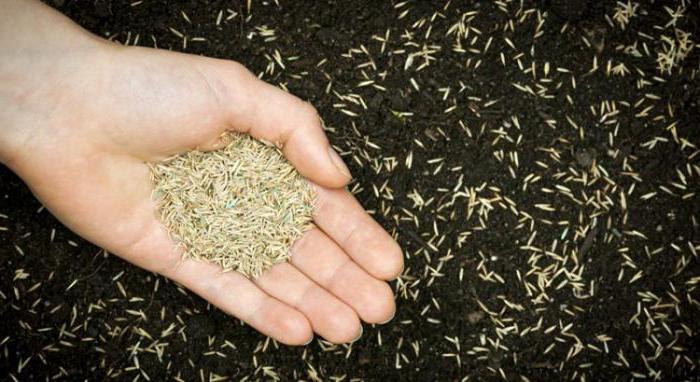

It doesn't take long to sow the seeds. One day is enough with a small area of the site. Sowing is carried out as follows:
- In order for the consumption of planting material to be uniform, the lawn is mentally divided into equal sections, and the seeds - into identical piles.
- The dry soil is sprayed with a spray hose. You need to wait a little while it absorbs the water.
- How to grow a lawn in the country? First you need to sow the grass. To do this, you should wait for a calm day. Seeds are scattered along and across the site. So they will evenly fall on the ground.
- At the end of sowing, you need to loosen the lawn with a rake, so the seeds will be embedded in the soil. Then roll the landings with a roller to compact the soil.
- The seeded lawn is watered using a fine spray.
The perfect time to plant your lawn
The best time for planning a site, planting lawn grass, flowers, arranging alpine slides, of course, is spring. At the end of March, you can already start preparing and feeding the soil, planning plantings, sowing early flowering plants. To saturate the soil with nutrients and abundant growth, they dig up the soil in the fall with the introduction of fertilizers. In the spring, seedbed preparation work should be started as early as possible.
Lawn grass can be planted throughout the warm season, from April to November. In spring, seed survival and germination occurs better for natural reasons. To prepare the soil before sowing seeds, the following activities are carried out:
The best time to plant lawn grass is in spring or early fall.
Benefits of autumn sowing
Each season has its own pros and cons for planting lawn grass. Each gardener chooses his time, analyzing all the possibilities and advantages for himself. Autumn planting is preferable for a number of reasons:
- lack of heat, which allows you to pay less attention to watering, has a beneficial effect on seed germination;
- soil and air moisture without sharp fluctuations;
- weeds are no longer growing as actively as in spring;
- shoots sprout in a dense layer and grow higher;
- the root system is formed stronger, and the grass is resistant to diseases;
- the soil does not require long preparations.
How to plant a lawn with seeds
Lawn grass seeds are very small, for sowing it is recommended to use 3-5 kg per 100 sq.m. Therefore, the seeds are sold in bags or large packages. Before sowing the seeds, moisten the area well and wait until the moisture is completely absorbed into the soil. For disembarkation, calm dry weather is suitable. The lawn is planted to a depth of 0.5-1.5 cm. For sowing, a seeder is used or the seeds are evenly scattered by hand.
In order to plant the seeds evenly on the site, use the cross-sowing method. For this, the seeds are divided into two parts. The first part is sown across the plot, the second part along. It turns out a kind of mesh (see video).
To prevent small seeds from being taken away by birds, or dispelled by the wind, they once again compact the soil with a roller. Then cover with burlap or other covering material.
Before germination, regularly watered with a watering can or a hose with a fine spray. The first mowing is carried out when the lawn reaches a height of 6-10 cm. Then the area is rolled again with a roller to exclude the formation of side shoots of grass. This procedure makes the lawn denser.
How to care for
In the first year after planting
Seedlings usually appear one to three weeks after sowing, depending on the type of lawn and air temperature. The slowest sprout are bluegrass, bent grass, clover, and, accordingly, they make higher demands on cleaning the soil from fast-growing weeds, since they simply cannot withstand competition with them.
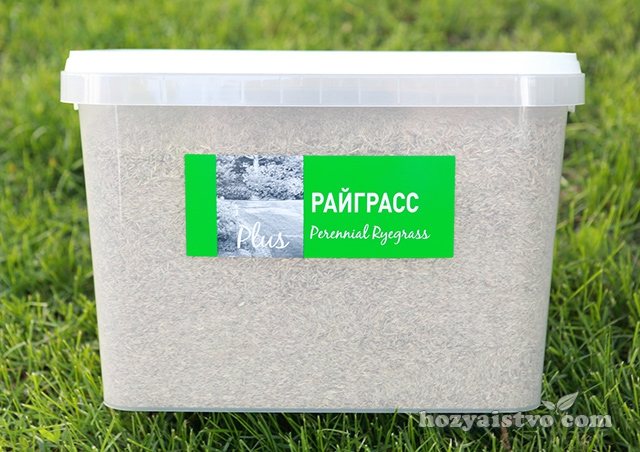

In a mixture of lawn grasses, perennial ryegrass is an indispensable component. It quickly occupies the territory, and then under its protection other more valuable narrow-leaved cereals - fescue, bluegrass - develop. If necessary, water the lawn carefully, in order to avoid sunburn of the leaves it is better in the evening hours. Remove weeds with a sharpened knife. The first shearing is carried out with a plant length of about 15 cm at a height of 10 cm. The height of the following haircuts is reduced, bringing them to 5 cm after one or two months. Do not overgrow the lawn, as the plants painfully tolerate a loss of more than 2/3 of height. In addition, lagging mowing can result in pale green patches on the lawn. Use a lawnmower with sharpened blades and a crop receptacle, or carefully harvest the cut grass with a fan rake. Staying under the cut grass, the plants can weed out. The mowing height depends on the type of lawn (for example, the parterre lawn is cut to a height of 3 cm, normal - 5 cm) and the conditions of the season (in a dry season, we recommend increasing the mowing height by 2 cm).
If you mow a lawn higher than 7-8 cm, there is another danger - less valuable broad-leaved grasses will be supplanted by narrow-leaved grasses, which, in fact, ensure the quality and aesthetics of the lawn. It is best to mow the lawn a day or two after watering.
When watering, the soil should be soaked to a depth of 15-30 cm. Frequent and weak watering leads to superficial root development. There are no clear rules for watering. Plants signal moisture deficiency by loss of firmness and wilting. Water the lawn when the surface layer dries up to 10 cm, in dry weather - once a week. The main thing is that the soil has time to dry out between waterings and the root system of the plants receives enough air. Excessive watering can lead to the appearance of mosses on the lawn, insufficient watering - to the displacement of lawn grasses by drought-resistant weeds.In the first year, if you have prepared the soil well, it is better not to feed the plants and not put undue stress (even if you sowed a mixture of lawn grasses for sports and games). Before leaving for the winter, in order to avoid winter damping of plants, the lawn must be mowed, but so that the grasses are gone before winter with a height of at least 10 cm.
How to plant roll grass
Roll lawn has a number of advantages over planting with seeds:
- low labor intensity of work on soil preparation;
- instant transformation of the site;
- good survival rate of the lawn;
- frost resistance;
- aesthetic appearance;
- the required density of the lawn;
- uniform color.
The rolled lawn is grown in special nurseries in compliance with the technology. It can be planted in early spring to late fall. Regardless of the time of planting, good survival rate and rapid growth are observed. To lay rolls of grass in the country, preparatory measures should be carried out correctly:
- Digging the soil. The soil is dug to a depth of 10-15 cm.
- Remove plant roots, clumps, stones, debris.
- The area is leveled with a rake.
- Fertilized with mineral and organic fertilizers.
- The site is compacted with the help of a roller, when pushing through, the earth is poured. They level and compact again.
For planting, a rolled lawn is taken no more than 3 days of exposure after removing the nursery from the soil. Ideally, you should plant the grass the day after cutting from the field. The rolled lawn is heavy (up to 20 kg), therefore considerable physical effort is required to deliver and roll out.
Laying is carried out in a staggered manner according to the principle of laying bricks. First, lay out one row, then lay out the second row so that the lawn joints fall in the middle of the previous row. The rows should be even, not overlapping each other. When the laying is over, the edges are leveled with a knife, the excess is cut off, the rolled lawn is rolled with a roller to eliminate air cavities. Correctly laid rolled grass will easily take root and in 2-3 weeks will become a full-fledged place for active recreation.
Lawn planting rules
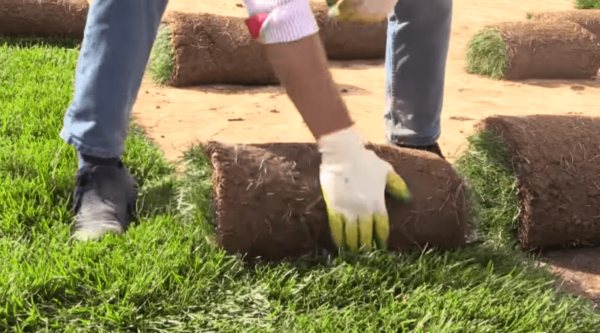

For those who find it difficult to comply with all the rules for soil preparation and planting, or there is no time, it is better to purchase ready-made lawn rolls. In nurseries, a sod layer is bred, then its upper part is cut off, together with the already formed cover, it is rolled up for transportation into rolls. After that, it is enough to lay it on the prepared ground so that it takes root in a new place. The soil is prepared in the same way as for seeds.
A roll lawn is convenient for embossed and shaded areas. Planting the seeds evenly and waiting for an even cover in such places is quite difficult and long, the finished sod layer is brought already cut, with top dressing, without weeds. But it is important not to delay planting and lay it no later than the next day after cutting.
Before laying the lawn, make sure that the area is clear of debris, unnecessary stumps, branches. For poor soils, you will need to add a layer of black soil on top, fertilizers are applied a week before the start of laying. When everything is laid, you need to water abundantly, repeating this every day for two weeks, then moisturizing is carried out as needed. After 10 days, you can start trimming.
Lawn Grass Care
Lawn maintenance consists of watering, cleaning, feeding and trimming frequently as it grows. There are rules that must be followed at different times of the year:
In winter:
In the spring:
In summer:
- trim the grass regularly;
- fed with fertilizers;
- watered once every 2 days.
Autumn:
Properly caring for the lawn grass, you can get a perfectly flat surface of emerald color for active games, picnics, summer vacations. With the help of a training video, we suggest learning how to properly plant and care for a lawn throughout the year.
Any person is pleased not only to look at the soft green lawn, but also to sit on it.Children especially love to run on green grass. A lawn that is planted and grown correctly can last a very long time. But sometimes it happens that if all the rules and instructions seem to be followed, it is not possible to achieve the desired attractiveness of the lawn. Why does this happen and how to properly plant a lawn with your own hands so that it pleases the eye? Let's try to figure it out.
To create the right lawn with your own hands, you should correctly select seed
... It is imperative to consider the purpose for which the lawn will be used, because there are different mixtures or grasses. The following types of herbs are used to grow a beautiful lawn:
- meadow bluegrass;
- common bluegrass;
- ordinary ryegrass;
- fescue;
- field grass;
- creeping clover;
- festulolium;
Sowing time should be considered when choosing seeds. Different types of herbs have different frost resistance and growth rates. For example, bluegrass grows rather slowly in the early years. Also, when choosing seeds, you need to take into account the height of the planned lawn in the country, the quality of the sod, etc. Different mixtures require different soil
, they can differ in seeding rate and many other characteristics.
Tools needed for planting and grooming
To prepare the soil, and then plant the lawn and take care of it, the following tools are required:
- metal and wooden rakes;
- wooden slats 1 m in length (several pieces for leveling the territory);
- mosquito net (used to protect seeds from exposure to sunlight);
- fertilizer (special lawn or complex): 50 g per square meter;
- fine spray watering can;
- Libra.
Of course, you will need high-quality seed material (preferably grafted) or several strips of rolled lawn.
Oats, rye and other cereals are often used for sowing. The best lawn grasses in the south:
- meadow bluegrass;
- meadow fescue;
- ryegrass.
Inhabitants of the northern regions are advised to give preference to grass mixtures intended for Siberia and the Urals.
If desired, lawn crops can be independently combined in suitable proportions, checking the success of the selected combination on the site next to the summer cottage.
Thus, there is no definite deadline for planting a lawn. You can sow seeds at any time of the year, except for winter. When choosing the time to plant, you need to consider the advantages and disadvantages of each season of the year.
What is the best time to plant grass?
When to plant grass for your lawn - in the spring or in the fall? You can sow the grass on the site at any time, from spring to autumn frosts. The main thing is not to hold out until the moment when the snow falls. There is no consensus on when to plant your lawn. Some gardeners are sure that the grass grows best if it was planted in May, others believe that summer sowing gives quick results, according to others, the lawn grass mixture should be sown in the autumn months in order to have a dense green cover by the next season.
Many gardeners prefer sowing in the fall.
, since they believe that from under the snow in the spring the grass emerges very amicably. But when to sow lawn grass in the fall? This should be done either at the beginning of September, so that the plants have time to rise before frost and they can be processed before wintering, or in the already frozen ground before the snow cover is established - in this case, the seeds will undergo stratification over the winter, will be resistant to diseases and will hatch together in spring.
Sowing in the spring is also popular, but, according to experienced specialists, the optimal time for sowing a lawn is at the end of summer. At this time, the soil is already well warmed up and moistened, there are much less weeds than in spring, and the seeds have time to germinate and take root before the onset of frost.Sowing in the spring, although it provides a beautiful lawn, but it is much more difficult to maintain it, because it requires regular watering and constant weed removal.
How to sow a lawn correctly in autumn
Why is sowing lawn grass in the autumn months good? The air is already moist enough, like the soil, the air temperature is moderate, the weeds grow worse. All these factors contribute to the rapid formation of shoots and the formation of the root system of the grass. Having sown the seeds of the grass mixture at the end of August or in September, you will get a lawn up to 10 cm high before the first frost.
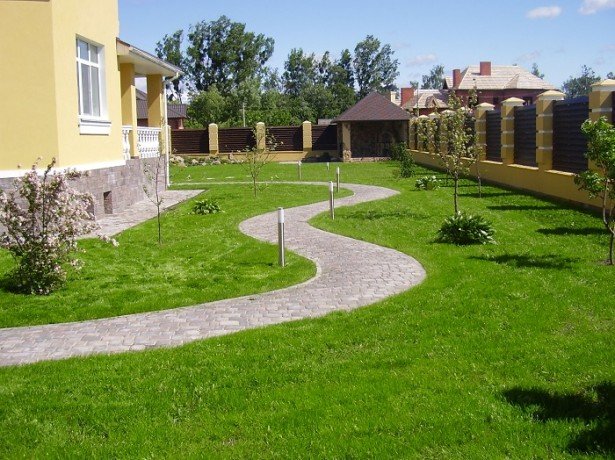

Sowing the seeds of the grass mixture in late August or September
In addition, planting lawn grass in the fall is convenient for those whose lawn area is not yet ready for the spring. A lot of time will pass while you free the area from excess debris, tamp and level the soil according to all the rules. But it is advisable to leave the land to rest for at least a month before sowing anything on it. If you can get your site ready for early summer, it is best to postpone sowing until the fall when conditions are more favorable for the grass to grow.
Typically, a lawn mixture contains several different types of grasses, but all have approximately the same air temperature and humidity requirements. Therefore, choosing the time for sowing seeds should be based on the general rule: at least 40 days should remain before frost. It will take approximately this time for the seeds to sprout, the plants reach a sufficient height, and the root system gets stronger.
In central Russia, sowing lawn grass in the fall should be completed by September 10, at the most until September 25. At a later date, the plants do not have time to grow and freeze slightly.
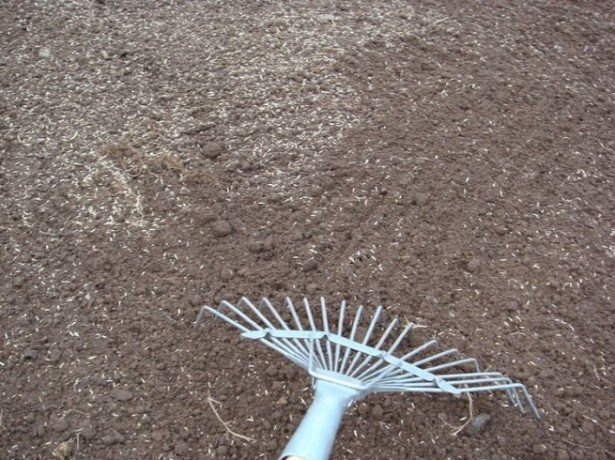

The time for sowing seeds should be chosen based on the general rule: at least 40 days should remain before frost
How is the sowing of the lawn carried out in the fall:
- from the summer, prepare the soil on the site by carefully leveling it and tamping it;
- a week before sowing, scatter a complex fertilizer with a predominance of nitrogen over the ground;
- level the soil with a rake;
- on a calm day, sow the seeds first along the plot, then across, scattering them manually in a fan so that the seeds evenly fall on the ground;
- lightly cover the sown seeds in the soil with a rake;
- sprinkle on top with a thin layer of peat and walk with a roller for the lawn, otherwise the seeds will be blown away by the wind;
- water the lawn using the sprinkler method.
How the autumn planting of the lawn takes place, the video will help you better understand - open the tab to the article and see how quickly and easily everything is actually done.
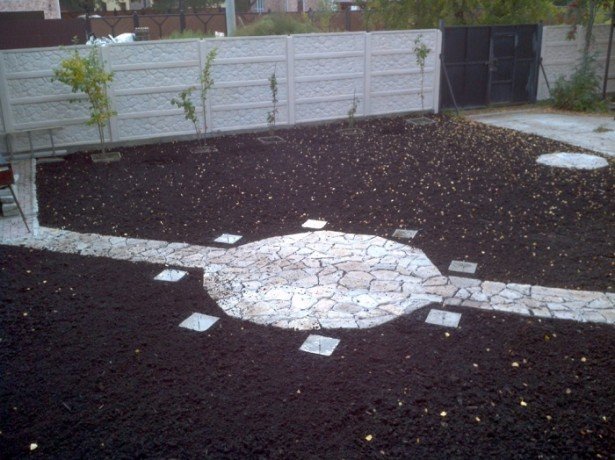

Since it rains quite often in the fall, there is no need for regular watering.
How to calculate the number of seeds?
To calculate the sowing of a grass mixture for a certain type of grass that is part of it, apply a special formula
, and the results are summarized.
The seeding rate of seeds (kg / ha) must be multiplied by the percentage of the amount of this species in the mixture and divided by the actual suitability of the seeds
... As practice shows, in order to sow lawn grass efficiently, it is necessary to increase the consumption of seeds by 2 - 3 times.
If only one type of grass is to be sown, then the seeding rate of the selected crop must be followed. On average, the consumption of seeds of lawn grass per 1 m2 is 30 - 50 grams
.
Seed selection
How to grow a lawn correctly? To do this, you need to select the appropriate seed variety. The type of the selected herb depends on what the future coating is intended for. It is not recommended to buy cheap mixtures, as they include lightly cultivated or forage grasses.
How to grow a beautiful lawn? A good lawn requires special types of grasses. The density of the turf should be high and the color of the cover should be dark green. Plants that are unpretentious in cultivation and care are selected. Lawns are sown with fast-growing, shade-tolerant, flower grasses and mixtures intended for sowing on slopes and roadsides.Today you can buy seeds in a shell, they are in demand among summer residents and designers. The seed-enveloping formula contains valuable nutrients that stimulate friendly germination and rapid grass growth on the lawn. The use of coated seeds saves money and time.
Seat selection
Sowing lawn grass begins with site selection. Grass mixtures can be planted almost anywhere on your site. Will fit:
- horizontal surface;
- the sun;
- shadow;
- slopes;
- clay and sandy soils.
In each specific case, only the amount of physical and material effort required to plant and grow a beautiful and green lawn will differ. Grass mixtures are best planted in a sunny place where rain and melt water will not stagnate.
Before you start sowing seeds, it is advisable to think over the scheme of the future lawn and even sketch it. It will be necessary to decide whether to leave trees on the site, grow individual flowers or arrange flower beds. It is necessary to decide in advance on the placement of landscape design elements, because difficulties may arise with cutting the grown lawn grass.
If a lawn mower is to be used, then when sowing the grass, you can leave a distance of one meter between it and fences, walls or curbs for convenience. In addition, you should not plant under a lonely bush or tree.
Diseases and pests
In most cases, lawn plants are damaged by fungal diseases. In most cases, they are caused by improperly built lawn cultivation technology. An excess of nitrogenous substances, excessive moisture, thickened plantings, accumulations of debris most often provoke the development of diseases on the site. The fight against them, as a rule, involves the use of appropriate fungicides or homemade folk remedies. The most common lawn ailments are:
- fusarium (snow mold);
- powdery mildew;
- rust;
- red threadiness, etc.
The most dangerous lawn pests are moles, earthworms and ants. To destroy them, insecticides are used, and various repellents are used to remove moles. On lawn grasses, you can also find other harmful insects - wireworm, bread mite, Swedish fly - but they are not so harmful. In the presence of healthy turf, the damage caused by them will quickly heal.
Growing a lawn is a difficult and time-consuming procedure, but with the necessary knowledge and skills, this work is greatly facilitated. The application of time and effort will allow you to get a beautiful, thick and dense lawn at the exit, which will delight the eye of a summer resident and a gardener.
Site preparation
Before sowing the grass, the area must be cleared of weeds and leveled. Such careful preparation helps to save you from weeding later and makes it easier to mow the grown lawn. It takes 1 to 4 weeks to prepare the site.
The area should be treated with a general herbicide. Those dacha places that are heavily overgrown with weeds must be processed in several stages. When the grass withers and withers, then it is necessary to free the site from debris, roots of shrubs, dried grass, after which it is leveled. If the soil is poor and needs fertile soil, then you can finally get rid of weeds by covering the lawn area with geotextiles. Thanks to this non-woven fabric, weed seeds will not be able to germinate and nothing will interfere with the lawn grass.
What are the requirements for raw materials?
Before sowing lawn grass, be sure to find out what it should be. So, the following requirements are imposed on plants:
1. Resistance to freezing.
2. Ability for vegetative reproduction.
3.The presence of a strong and branched root system, which can grow in dense soil, and also does not collapse.
4. Ability to germinate in certain climatic conditions.
5. Beautiful decorative qualities: color, height and density of shoots.
6. Ability to respond well to feeding and quick recovery of the carpet after mowing.
Soil preparation
Before sowing a lawn, you need to lay favorable conditions for a friendly and rapid emergence of grass shoots and its further growth. The need for fertilization depends on the type of soil. If it is acidic, then slaked lime or chalk must be added to it, and clay areas with heavy and dense soil are loosened with humus or vermicompost.
Mineral fertilizers should be applied at the same time. If the sowing is spring, then the emphasis is on nitrogen fertilization, which causes the rapid growth of grass, and in the fall, to facilitate the wintering of seeds, more potassium and phosphorus are introduced.
The soil and additives should be evenly distributed over the entire area, after which the soil is loosened and slightly moistened. The leveled section is rolled using a special roller. If irregularities and holes are suddenly found, then they are poured or cut off, and then rolled again. Once the ground is leveled, it should lie down for several days
.
How to grow a lawn before winter
How to sow a lawn with your own hands
Autumn weather can bring unpleasant surprises in the form of unexpected frosts in early fall, shortly after sowing the seeds. To reduce the risk of planting death, they practice planting seeds at the end of autumn, after the soil has time to freeze. The procedure should be completed before the plot is covered with stable snow. Seeds must be planted on a day when the air temperature is positive. The planting procedure is the same as for autumn sowing, and at the end the seeds should be mulched with peat chips.
Note! The positive aspects of the considered method are that the low temperature reveals the hidden potential of the seeds, and as the snow melts in the spring, a significant amount of moisture will accumulate in the soil, which the lawn needs. As a result, the grasses will immediately begin to grow actively in the spring. By the summer, it will really be possible to get a high-quality full-fledged lawn. In addition, such plants will be more resistant to diseases and pests, and will also be resistant to drought and low temperatures.
Sowing a lawn in frozen soil also has its own disadvantages. First of all, this method is not suitable for use on slopes. In the spring, melt water will flow through them, which is able to completely wash off the entire upper soil layer along with the seeds. In addition, a positive temperature in November can last for a relatively long time, and during this time the seeds will have time to hatch and germinate. When full-fledged winter frosts come, the seedlings will certainly die. To increase the chances of plants for survival, seed should be sown at an increased seeding rate, and with the onset of spring, additional seed should be sown where the plants are frozen.
Note! The best results for autumn planting are observed when the mixture contains at least 5 different plants.
In some cases, seeds are sown in the spring. Usually, the procedure falls in the second decade of May and is carried out according to the standard procedure.
How to sow lawn grass with your own hands?
Before planting a lawn, it should be mentally divided into several identical areas. The seeds should be divided into the same number of parts in order for the seeds to sprout evenly.
How to sow lawn grass correctly with your own hands? Seeds should be embedded in the soil to a depth of 1 - 1.5 cm. First, they need to be scattered along, and then across.
... This helps the seeds to lie down evenly.If possible, you can use a manual seeder. It is much more convenient, but you can also plant a lawn with high quality manually. So that the wind does not carry away the seeds, they should be sprinkled with a centimeter layer of peat and rolled. After that, the sown lawn is watered from a watering can or a hose with a fine spray. Watering should be done in moderation, otherwise the soil may become waterlogged.
Tools needed for planting and grooming
For soil preparation, sowing and further care, gardeners will need tools to help keep the lawn in perfect condition:
- rake (metal or wooden);
- roller or other device for compaction of soil;
- several slats made of wood (1 m long);
- mosquito net (protects seeds from direct sunlight);
- complex fertilizers (for every square meter - 50 g);
- a watering can with a spray (it is better that the holes are small);
- aerator;
- scales for weighing seeds, herbicides or fertilizers.
The main tool, perhaps, are seeds - they must be carefully selected from trusted sellers.
Lawn care
The lawn must be properly maintained, otherwise it will fade and overgrow. Mowing and watering play an important role in this process.
Watering features
Immediately after sowing the grass, if the soil is dry, you need to carefully water the area weak pressure
otherwise the seeds may wash out. Watering in the future should be regular, but the weather conditions should be taken into account.
It is also necessary to water the lawn after mowing so that it recovers, takes on a neat appearance and rich color. Experts recommend watering your lawn in the evenings.
A haircut
Mowing your lawn is required to keep it looking good. In addition, it is a good way to control weeds and stimulate vegetative development, which leads to the formation of additional shoots and development of the root system, contributing to the creation of dense turf.
Before mowing, the lawn should be checked for foreign objects. For the first time, the lawn begins to mow in 1 - 1.5 months after the emergence of sprouts. In height the first haircut should be at least 6 - 8 cm
, and all subsequent ones should be 3 - 5 cm. In spring and autumn, one centimeter is added to this height.
In this way
In order to properly arrange their summer cottage, many gardeners plant grass for the lawn. This makes the landscape design more attractive and pleases the owners with its beauty. Lawn maintenance depends on the type of grass selected. Sowing is best done in the fall, this will allow you to get strong plants without weeds.
Ordinary lawn
This is the most common type. Sowed with a stable mixture of "Sport and Play", which is not threatened with trampling. It includes special varieties of grasses capable of forming dense turf. Such a mixture is suitable for playgrounds and sports grounds; it is sown around the barbecue area. There are many special mixtures that are used for sowing shaded areas, such as "Shady Garden". If you use a mixture called "Lilliput" for sowing, you can cut the lawn by three times. For a versatile area without active walking on it, a universal mixture is ideal.
Let's talk about secrets ...
Have you ever experienced joint pain? And you know firsthand what it is:
- inability to move comfortably and easily;
- pain during or after exercise;
- discomfort when going up and down stairs;
- inflammation in the joints, swelling;
- unpleasant crunching, clicking not on their own;
- unreasonable and unbearable aching pain in the joints ...
We ask you to answer the question: does this suit you? How can you endure such pain? How much money have you already spent on ineffective treatment? It's time to end this! Do you agree? Today we publish an exclusive interview with Professor Dikul, in which the doctor revealed the secrets of getting rid of joint pain, treatment of arthritis and arthrosis.
Attention, only TODAY!
Who doesn't want to have an ideal green lawn on a personal plot or in a country cottage, exactly the same as in the photo in a magazine? Not a lawn, but a dream. And, of course, every gardener knows what kind of work is hidden behind glossy images in fashion magazines. In such a matter as planting and caring for lawn grass, there are many nuances and little things that you must pay attention to. Otherwise, all the labor and money invested will simply go nowhere. For example, the question of when to plant lawn grass is very important.
What are the lawns
Gardeners have 4 types of lawns:
- English, or parterre;
- garden and park;
- meadow;
- Mauritanian;
- sports.
Of these, only English is for decorative purposes. You cannot lie on it, play, or have picnics. Needs regular care: haircut, watering, fertilizing. The herbal mixture is expensive compared to others. Only the ideal preparation of the soil for the lawn can ensure an even mowing of the grass carpet. Even a small bump or fossa will be clearly visible from afar.
Garden and park is more resistant to loads, has a certain composition of grasses, is not afraid of shading from trees, cold, prolonged rains. It is cheaper to set up and maintain than English. Most often used in summer cottages.
For your information! Meadow is more resistant to stress, unpretentious in care, also has a specific composition of herbs. Suitable for home lawns and large areas, does not require frequent mowing of grass. It contains herbs that bloom all summer.
Moorish differs from the rest by the abundance of flowering herbs. They are pleasing to the eye all summer long. They are mown only after all the flowers have withered: in late summer and autumn. Does not require any maintenance, except for watering in dry summers and mineral dressing.
Sports differs from the rest in the composition of the herbs. They are selected in such a way that he is not afraid of heavy loads. The lawn is not afraid of trampling and is specially designed for sports fields. You can play football, have picnics, just relax on it, but it is very demanding to care for. It needs to be watered regularly and mowed weekly.
Spring or Autumn
The time for sowing lawn grass is not strictly limited. You can start planting grass already when the ground has warmed up a little, from early spring. Of course, there is a direct dependence on climatic conditions and the region where sowing is planned. It is advisable to do this, in principle, until late autumn, while the first frosts have not yet come. And definitely, it is too late to plant lawn grass when the first snow falls. There is, of course, the best time for this: the end of summer, when several factors necessary for a successful sowing coincide very well. The ground is very well warmed up and has optimal humidity. In addition, weed plants are no longer as active as in spring, and the sown grass will have time to rise before frost. Sprouted seeds will have time to harden and will be fully prepared for wintering.
If you choose the autumn season for sowing, then here it is necessary to take into account several factors, and only then make your choice. It is better to sow the lawn in the personal plot and summer cottage at the very beginning of September or in November, when the soil is slightly frozen. Why? It's simple.
If you choose the first month of autumn for planting, then the grass will have time to rise before the onset of a cold and snowy winter. And if planted in a soil slightly touched by frost, the seeds will undergo stratification during the winter, which will allow them to become stronger and more resistant to various diseases that lawn grass is susceptible to.
It should also be borne in mind that the grass planted in the fall can be supported with fertilizers high in potassium and phosphorus in order to make the roots of future seedlings stronger and more powerful. But the nitrogen content in such fertilizer should be minimal.This will increase the resistance to low temperatures on the immature plant.
Those experts who believe that it is better to sow grass in the spring also have their own reasons for this opinion. Long-term observations show that the lawn grass sown in early May emerges and develops most actively. Summer sowing allows you to enjoy the result in the current season. Although the grass planted in spring or summer will require more painstaking and careful maintenance. You will have to water and remove weeds from such lawn grass much more often. Fertilizing the soil where lawn grass will be planted in the spring-summer period is more expedient and better with fertilizers containing many nitrogenous compounds. This will contribute to the growth and active full development of plants.
In favor of the opinion that it is better to plant lawn grass in early spring, the need to take into account the composition of the mixture of seeds that you choose for planting in your personal plot or in the country speaks. If it includes types of grasses that are characterized by slow growth, then this should also be taken into account when choosing a season for planting. These are, for example, many types of fescue or bluegrass.
Lawn grass should be planted only when dry, as calm as possible, the weather is established. The seeds are extremely light, even a slight gust of wind can carry them over a long distance throughout the site. It is easier and more convenient to sow grass in dry and granular soil; it is generally problematic to plant lawn grass in soil moistened by irrigation or rain. But immediately after sowing, the grass can and should be watered abundantly. It is better to do this in two steps. First, pour plenty of water over the entire sowing area using a hose, preferably with a spray nozzle. Water so that there are puddles of water on the ground. Wait until all the water gradually goes into the soil, and then you can start the second stage of watering.
Experts believe that only sown lawn grass should be watered for at least two hours. The ground should be moistened about thirty centimeters deep. Only if this condition is met, it is possible to achieve high-quality and simultaneous germination.
When planting lawn grass of any kind, it is important to adhere to the general universal recommendations:
Features of planting grass grown in the house
In order not to suffer with seeds in your area, you can scatter them in pots or other containers filled with soil. Naturally, the soil must be prepared. This whole procedure is done in the house. In this case, you do not worry about the destruction of seeds by birds or adverse weather conditions. Naturally, you need to remember to take care of the grass.
In such conditions, you will have to carefully monitor the feeding and watering of plants. After the sprouts reach about 5-8 centimeters, they can be planted on the site. Naturally, this should be done carefully so as not to damage the root system. That is, remove the grass from the container along with the earth. Then lay it on the site and tamp it.
You need to approach the landing carefully and carefully. Try to keep the grass uniform in height and density.
Lawn care in the first year
It is not very difficult to take care of the already appeared lawn, but patience and painstaking work will be required from the lover of the emerald-colored grass. In the first year of your lawn's existence, try to walk on it as little as possible, let it strengthen, do not overload the young grass. Our pets can also pose some threat to the condition of the green carpet, so make sure that the animal does not significantly damage the lawn. Also, work on cleaning the lawn from weeds will become permanent, there is no escape from this. And, of course, it is necessary to study the technology of correct mowing of lawn grass. Do not cut more than 1 centimeter of grass for the first time.In the future, to maintain the appearance of the lawn you need, mowing should be done regularly, but do not forget that it is not recommended to cut the stems by more than one third.
The lawn does not have to be green grass cut short in a classic style. It can be flowering - Moorish or meadow, sports - resistant to abrasion, or garden. The choice of seeds for sowing and subsequent care depends on the type of lawn, for example, the frequency of mowing and feeding, watering and aeration. Soil preparation for different types of lawns is carried out using a single technology.
When is the best time to sow your lawn?
There are no strict rules for sowing a lawn. It is necessary to take into account the time for the preparation of the site, the soil, for the germination of grass. That is why the best time to start work on the design of the lawn is considered to be the period from mid-May to early September. On average, lawn seeding and germination work takes 4 to 6 weeks, and it is best to finish them before snow and frost.
Site preparation
The first and most important stage at which the future lawn is marked, weeds are cleaned and leveled. Careful preparation will save you the hassle of weeding and make it easier to mow your already grown lawn. The time required to prepare the site is from 1 to 4 weeks.
Fertilization and soil preparation
The second stage, at which favorable conditions are laid for the quick and friendly emergence of seedlings of lawn grass and its subsequent growth. The need for fertilization depends on the type of soil. It should be fertile, friable, pass and retain moisture well and contain a sufficient number of elements that ensure rapid growth. The lead time is from 3 to 7 days.
Sowing rates are usually indicated on the seed package and may vary for different types of lawns. Do not skimp on quantity - the “bald spots” on your lawn will not remain bare for long, very soon they will be occupied by weeds, and you will have to repeat everything again. The time it takes to sow the grass is short - if the lawn is small, you can do it in a day.
Lawn care
During the period of emergence and rapid growth of grass, the lawn needs regular maintenance. It consists in regular watering, removing the remaining weeds, as well as cutting young grass. It is not recommended to walk on the lawn before the first mow.
A two to three year old lawn with evenly growing grass is considered mature. Such a lawn needs not only watering and mowing, but also aeration, as well as additional fertilization. At the same time, a strong and healthy root system will not allow weeds to sprout and sprout by chance seeds, and your lawn will delight you with lush green grass for a long time.
Perennial Moorish lawn
It is called meadow. Sow with cereals and annual and perennial flowering grasses. Usually they take 10-20 species, which are notable for their small stature. A mixture of cereals and herbs is sown in the far corners of the garden. Such a lawn resembles a natural plant community, the ecological balance of which is difficult to maintain. If you choose the right Moorish lawn, it will bloom from June until the first frost. Meadow grasses smell good and attract insects, birds and even lizards with their flowering.
General recommendations
To get the desired decoration of the site in the form of a green lawn, you need:
- first, choose the right place for sowing grass in the country;
- then pick up the right seeds;
- then carefully prepare the site for processing;
- it is not enough to water the soil before sowing the seeds, otherwise they will stick together;
- mow and irrigate a new lawn every 20 days with a sprayer;
- do not wait for results throughout the year, since a normal lawn is obtained only 24 months after sowing.
Any novice farmer must decide for himself whether to use seeds or purchase a ready-made cover.If the first option is preferable, then all the instructions of the specialists must be carefully followed, otherwise all the work will go down the drain.
A lawn is an area of land with artificial turf. For its sowing, specially selected seeds are used. In addition to the decorative function, lawns also play a practical role - it is pleasant to spend active rest and play sports on them. You can decide which lawn to plant in the country and find out how to sow grass for the lawn by studying our instructions.
How to sow a lawn with your own hands - video
Drainage (as needed)
Any guidance on how to plant lawn grass correctly includes instructions on how to set up a drain. If the site is in a good place, it is not flooded by rains and rising spring water, then it is enough just to dig it up, lime it and fertilize it. In other cases, it will be necessary to create a drainage system, which is carried out in conjunction with the leveling of the relief.
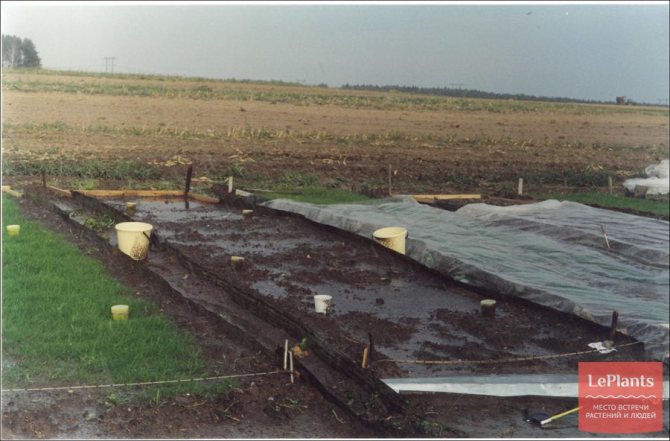

ON THE PICTURE: If there is stagnation of rainwater on the site, then drainage is simply necessary.
For this, the fertile layer removed during the leveling is laid on top of two drainage layers, the lower of which includes coarse gravel or broken brick, and the upper one consists of small stones or sand. Thus, a three-layer base is formed on the site:
- from above 15–20 cm of the fertile layer;
- below 10-15 cm of sand (fine gravel fraction);
- at the base of 10-15 cm. large stones.
Each layer is carefully rammed as it is laid.
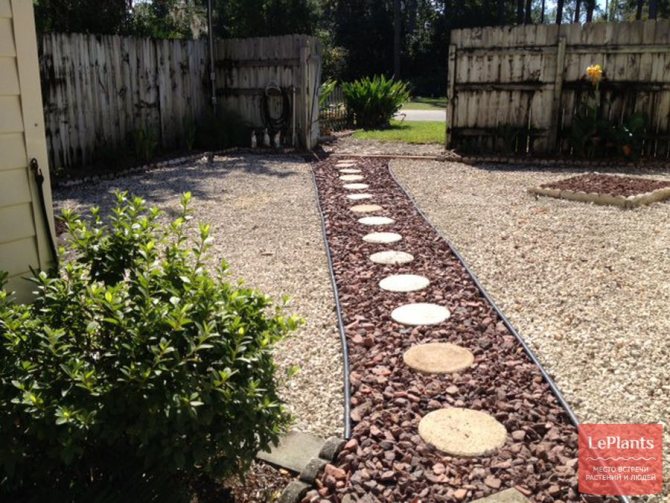

ON THE PICTURE: General view of the site immediately after laying the drainage under the lawn and garden path.
Which type of drainage to choose for a lawn depends on the size of the area, the proximity of groundwater, already laid communications and a host of other factors, which we will definitely touch upon in our separate article on drainage.
How to mow and care for your lawn?
The beauty of the lawn directly depends on the care: watering, mowing, weeding. In addition, you need to monitor the formation of bald spots by planting new seeds. To do this, sprinkle good soil on a bare area, and then add seeds and water regularly.
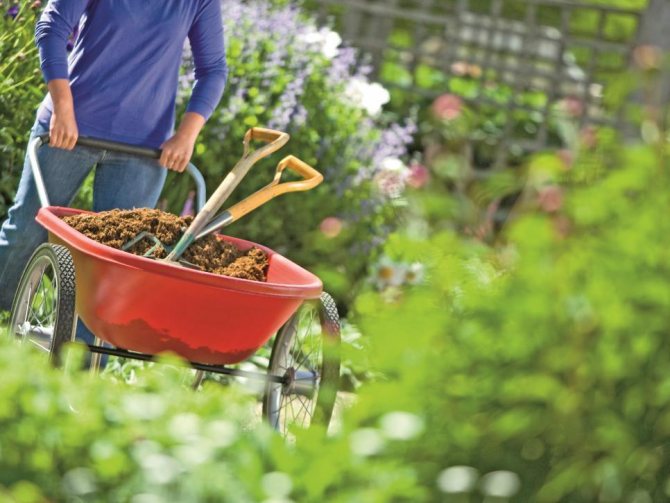

The first mowing of the lawn should be carried out on dry grass, starting with regrowth of 8-10 cm, and removing only the tops by 1-2 cm. During subsequent mowing, the height of the grass can be left at your discretion, but not less than five centimeters.
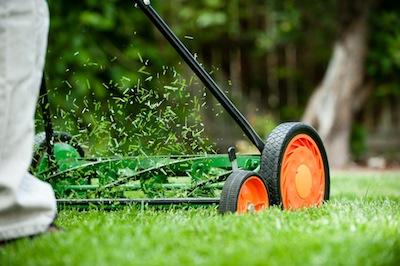

Weed removal
To create lawns, special herbs are brought out, pleasing the eye with juicy flowers and giving a pleasant tactile sensation. Any weed will spoil the impression, therefore it is important to get rid of extraneous vegetation.
There are two ways:


- mechanical. Sod is cut to a shallow depth and stacked in stacks with the roots up. Six months later, the cut soil is used as humus: it is free from weeds and is rich in nutrients;
- chemical... The site is treated with herbicides, for example, Roundup or Reglon. The poison infects the plants completely, penetrating through the aerial part into the roots, so that after a few days the site becomes clean. When using pesticides, it is important to strictly adhere to the instructions, otherwise they can subsequently harm beneficial plants.
To avoid herbicide damage to lawn grass, sowing is started no earlier than 6 weeks after treatment. During this period, weeding is regularly carried out, destroying the remaining weeds.
Digging
As we wrote at the beginning of the article, there are lucky ones who do not need to worry about the quality of the soil on the site. But this does not mean that you can avoid digging the ground before planting. You can call for help and heavy equipment (cultivator), or you can do with a shovel (which will be even better). By the way, digging is another opportunity to remove weeds from the soil that have not died from chemistry. Dig dry soil 25 cm deep. This is the so-called single-tier digging.
Is there a two-tiered digging? Yes.This digging is used for plots of land that have not been cultivated for a long time. A furrow is dug across the lawn area to a depth of 25 cm (shovel bayonet), and a layer of earth is loosened with a pick. In the next furrow, select the loosened soil and cover it with soil from the previous furrow.
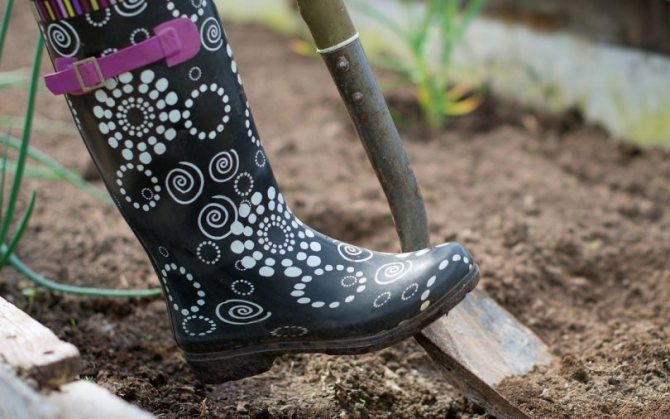

Digging up the ground, you solve several problems at once: you remove the remaining weeds and fertilize the soil
But if the soil for sowing the lawn leaves much to be desired, then you need to think carefully about how to prepare the soil for the lawn. There is an option to replace the existing soil with a fertile one. This is a complex process. It is necessary to remove 20 cm of soil and fill in another. You ask: "where to get the right soil for the lawn"? This is done like this: we mix part of manure + 2 parts of peat + part of loam. Here is the answer to the question of how to prepare fertile land for a lawn. The second option is not so time consuming, because it consists only in the enrichment of infertile soil. To do this, add peat, manure, sand and loam to the existing soil and dig everything up with the old soil.
What soil is best for lawn grasses? Experts say that it is a loam with a neutral pH level.
As a rule, digging is accompanied by the laying of a drainage system. Before sowing a plot, you need to carry out communications and lay drainage. If the groundwater is deep, build surface drainage. Surface drainage serves only to drain excess moisture after precipitation. In other words, it prevents puddles from accumulating. If the groundwater comes close to the ground, then deep drainage is needed here. Note that the creation of deep drainage requires even a specialist consultation.
To summarize: how to make a lawn in the country with your own hands
Follow our instructions, regularly care for the lawn after winter (in spring), use watering and aeration on time, do not forget to properly cut the grass.
What is the best lawn grass? Think over this moment, taking into account the conditions of the site and its purpose. Responsibly approaching the matter and applying all our tips, you will get a beautiful green lawn.
If you want to see more clearly how to sow a lawn correctly, watch our video.
18
Rammer
Lawn preparation includes tamping. For future sowing of seeds, you need to compact the soil. Tamp the dug and leveled soil with a hand roller weighing ≈ one centner. Although you can use a simple board. Do not allow anyone to roll the ground after or during rain. Walking on compacted and tamped ground is not allowed. Carefully compacted soil will allow the seeds to lie evenly in the ground, and this in turn will help them swell and germinate.
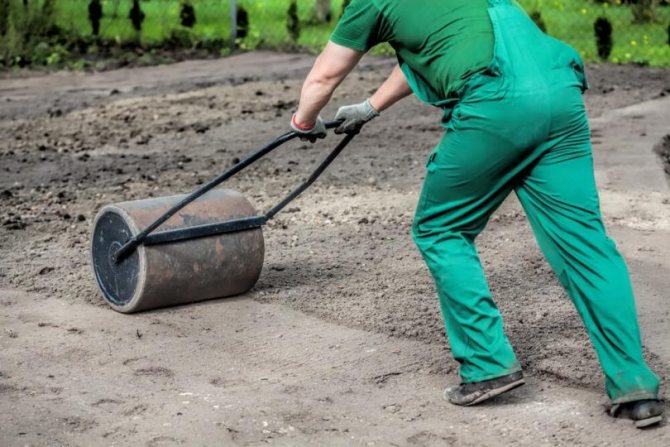

Tamping is best done in dry weather.
We figured out how to tamp the ground under the lawn, now let's move on to the next final step.
Which is better - a set or a separate variety?
Before planting seeds, the question arises - what to buy? A set of seeds of one or two types, or buy a ready-made mixture? In fact, it all depends on your conditions.
- High trampling. If you plan to constantly gather with friends in the planted area, play tennis, various outdoor games, set up a playground, etc. - it is better to definitely choose a mixture marked "Sport". Of course, it will come out more expensive than one kind of seeds in a garden store, but such planting material is the most powerful and resistant varieties to physical stress. She will do her job and you will not waste several years on lawn cultivation.


- Low trampling. Do you just want to create a beautiful green area (lawn) next to your house or fill the space between the paths in the garden? Then you can experiment! Explore the types and subspecies of the varieties above, choose the ones that you like, and try to combine them together.Basically, almost all lawn sets consist of the types listed above (you can see this for yourself by wandering around the garden store and examining the composition of the packages). So why not try yourself in the role of the compiler of such a set?


Photo gallery
Here you can see in the photo how you can decorate the landscape design of any site with a lawn.
Drainage device
How to prepare the land for a lawn with a high water table or in a wetland? To do this, you will need to make a high-quality drainage of excess water. The type of drainage system is selected depending on the soil and the level of groundwater rise during peak periods. For sandy loam soils, as well as when the site is located on a hill, with the natural removal of excess moisture (the presence of deep ravines, ditches, etc. nearby), a drainage device is optional.
There are two options for drainage systems:
- solid;
- channel.
Note! Continuous drainage is arranged only for heavy clay soils. For this, a completely fertile layer is removed and gravel, sand, broken brick, small stone about 150 mm thick are laid on the clay. The preparation of the area for the lawn provides for a drain for excess water in its lower part.
Canal drainage systems are used on waterlogged soils with a high level of groundwater and the risk of flooding the site as a result of snow melting. The easiest way of the device is digging ditches and filling them with small stones, gravel sand. For swampy areas, drainage is made from asbestos or plastic pipes. They are placed in cushions of sand or fine gravel. For proper laying, you need to make a geodetic survey of the plot with the determination of the direction of drainage of ground and melt water. Duct systems are expensive and labor-intensive to implement.
Parcel surface leveling
Before sowing the lawn, the area must be leveled as flawlessly as possible. Masters of English lawns use a building level at this and at the stage of tamping, and this is quite justified if you want to get a perfectly even green carpet. Relief planning is carried out in clear weather, when the soil is dry and loose. At the same time, it is not necessary to remove the slope, if any. On the contrary, it will provide a drain of rainwater, which is especially important in recent summer seasons, rich in heavy rainfall. However, this bias must also be leveled.
Pits and lowlands on the site are leveled in one of two ways: remove soil from hills (bumps) and move into pits, or fill low-lying places with fertile soil from other parts of the garden... If the site is still fresh and fertile, it is replaced with purchased peat soil. Heavy clay soil is mixed with sand to make it more permeable to air and water.
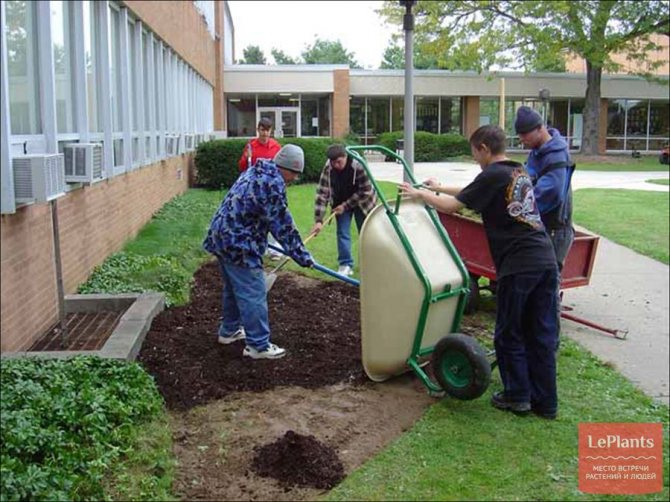

ON THE PICTURE: For pits on the site, it is better to use purchased peat-based soil.
- pH: 5.5–6.5;
- humus: 2.5 to 3.5 percent;
- nitrogen and its compounds: 10 mg. per 100 g of soil;
- phosphorus: 15-25 mg. per 100 g of soil;
- potassium: 20-30 mg. per 100 g of soil;
- trace elements: control of copper and zinc content.
Parcel hovering
This stage is often skipped because it takes extra time and effort. However, it has obvious advantages:
- The point of steaming (steaming) is to rid the area of weed seeds and wheatgrass rhizomes.
- If the lawn will be sown with seeds, it is better not to skip this step. If turf (roll lawn) will be laid, then it is not necessary to keep the soil under steam.
- The mating period is one to one and a half months. The method consists in regularly removing germinating weeds and applying herbicides just before the final stage of preparation.
In recent years, instead of standing the site under fallow, it has been successfully sowed with green manure grasses: sweet clover, lupine, white mustard, vetch and the like.They are sown 1.5 months before the creation of the lawn, and before laying the sod or planting lawn seeds, the green mass is plowed (they dig up the soil directly with the plants). This improves the structure of the soil and enriches it with nitrogen and other substances in a form more convenient for assimilation.
Selection of suitable seeds for sowing
Let's start by choosing seeds for your lawn. There are many ready-to-use mixtures on the market for various lawns purposes. Their names usually coincide with the target orientation of the future lawn - "sports lawn", "fast lawn", "decorative lawn for shady places", etc.
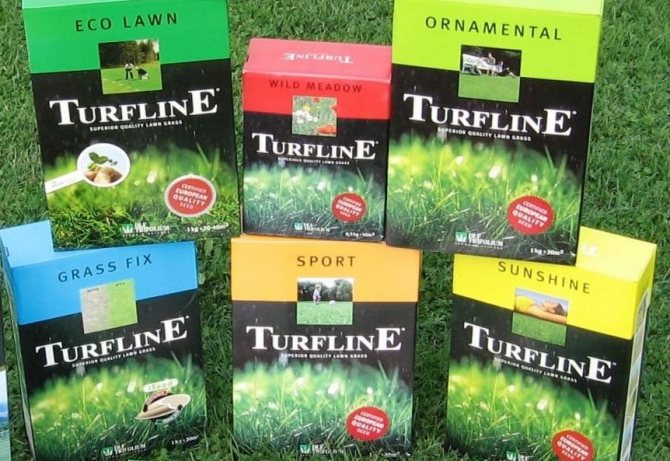

When choosing a mixture for a lawn, pay attention to its species composition
Typically, consumers do not think about which lawn grass is better to plant. They are guided only by the name, without looking into the composition. They buy any “universal” lawn, and then they are surprised that in the second year the lawn is almost completely frozen or covered with ugly bald patches. And all because most manufacturers bring their trains from Western Europe or compose them according to local standards. And that is why very often the ready-made grass mixtures contain seeds of non-frost-resistant plants that are not adapted to our climate.
For example, the most famous such representative is ryegrass... It is found in almost every ready-made mixture, and in a fairly large amount (sometimes - up to 50-60% of the total number of seeds!). For Europe, ryegrass is an excellent lawn grass. It sprouts very quickly and covers large areas, is highly decorative. The only "but": the lifespan of ryegrass, even in ideal European conditions, does not exceed 5 years. And in our country ryegrass almost completely freezes out in the first winter, leaving bald spots on the lawn.
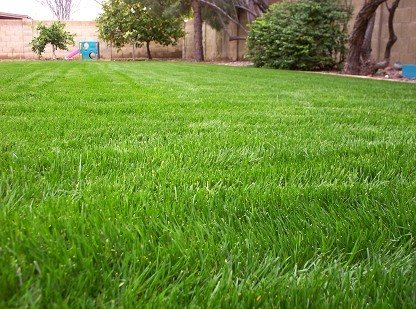

Ryegrass is often used to create "quick" lawns, for example, before the delivery of a commercial landscape property
For the climate of the middle lane, the best lawn grasses are red fescue and meadow bluegrass... They form a dense herbaceous cover of bright green color, have high frost resistance and durability. Fescue is more unpretentious, shade-tolerant, grows quickly. Bluegrass is gaining strength more slowly, but is more decorative than fescue. It is not in vain that many gardeners admit that the most beautiful parterre lawn grows from meadow bluegrass, ideally when using one variety of this grass.
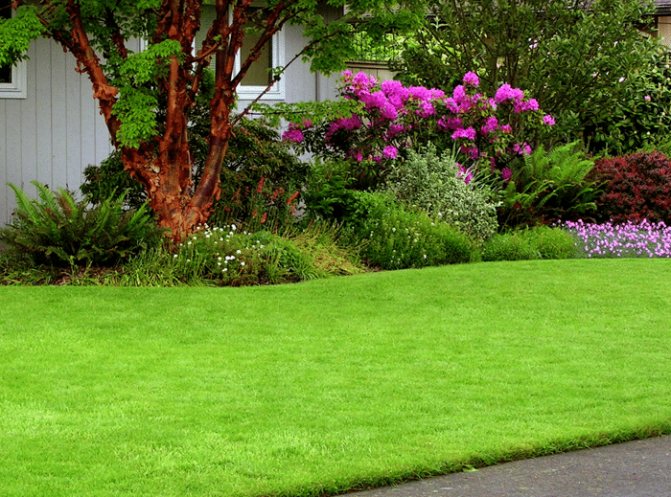

The bluegrass lawn is one of the most decorative. In addition, it is distinguished by its endurance and resistance to trampling.
If you find a mix of different varieties of bluegrass and fescue on sale, great. For example, Premiumline's Ideal blend contains only these herbs in a 50:50 ratio. You can buy fescue and bluegrass separately, mix and sow. It is the safest option for creating a decorative and at the same time sustainable lawn.
You can sow seeds from May to September. The main thing is that the lawn is already strong enough before winter. And there is one point. If you decide to create a lawn in the spring, then the amount of seeds for sowing can be taken a little more than indicated on the package (for different compositions, this amount can be 10-25 g / m 2). This will allow you to get a thick lawn faster. As the grasses grow, they will begin to compete with each other, and by the fall, only the strongest will survive. They will form a lawn that will survive the winter without loss and begin to spike in early spring.
In August-September, sowing grass in excess is undesirable. Strong specimens will not have enough time to defeat weaker neighbors. Strong competition will lead to the fact that the blades of grass will go away before winter in the stage of struggle with each other, which means they will be weakened. Most likely they will not be able to survive the winter and will die.
In other words, lawn grasses will have a better chance of forming good, dense turf during spring planting.
How to grow ornamental grasses
Dig a hole about twice as wide as the plant pot itself. Place the plant in the hole so that its base is at ground level. Gently loosen and distribute any roots that are wrapped around the plant. Feed with compost, backfill soil, water, and mulch to retain moisture and retain nutrients.
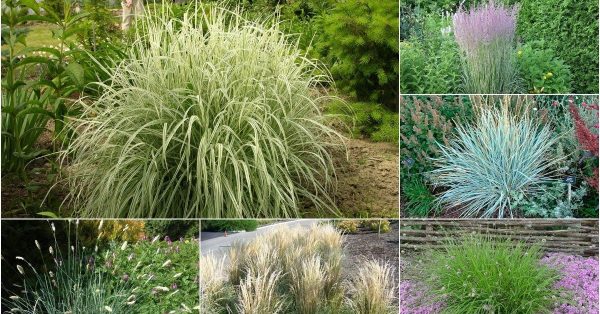

Technology for competent lawn planting
Now that you have decided on the planting season and the type of lawn grass, let's start sowing. Let's consider step by step how to plant lawn grass in the country and how to care for seedlings to get a beautiful lawn.
Step 1. Removing weeds on the site
In the area where you plan to break the lawn, you need to destroy all weeds. For this, different methods can be used: manual removal, deep cultivation, mulching, herbicide treatment.
The most effective way is to use herbicides. For example, spraying with Roundup helps to destroy even the smallest roots of all types of weeds. The drug penetrates into plant tissues through leaves and young shoots, then reaches the roots and kills them. Complete destruction of weeds by this method occurs 2-3 weeks after treatment. When this happens, yellowed and dried weeds are removed, after which they proceed to the next step of soil preparation.
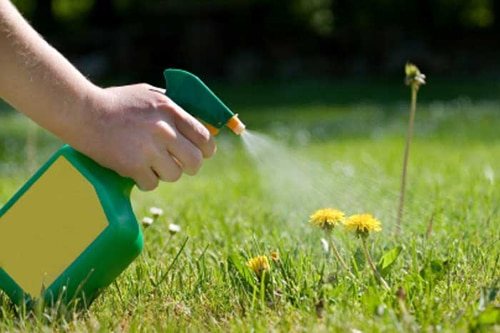

Roundup is a continuous action herbicide. Therefore, the destruction of weeds with this drug is carried out only before sowing the lawn
Step # 2. Soil cultivation
The earth is dug up to the height of the blade of a shovel, stones are picked out, dried roots - everything that can prevent the thin roots of the lawn grass from growing. Large lumps of earth are broken up so that the soil thickness is loose and homogeneous.
At the stage of digging, they try to level the surface of the site so that there are no bumps and holes left on it. Water will accumulate in the pits, which can lead to excessive wetting of the grass and rotting. On the bumps, there will be difficulties when passing the lawn mower. Leveling is carried out by pouring or, conversely, sampling soil in problem areas.
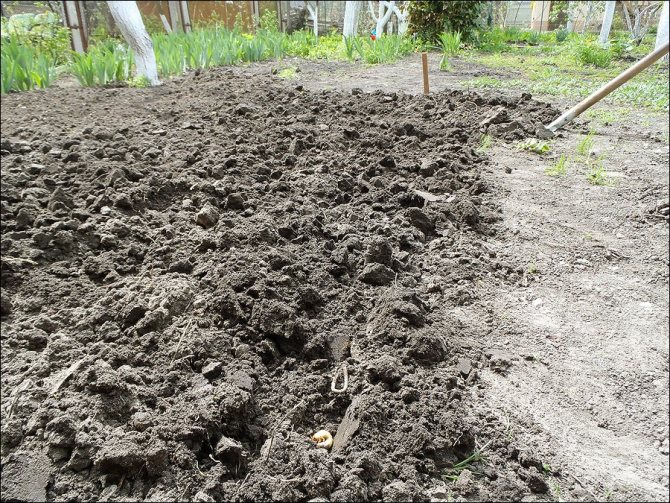

Presowing soil digging to the depth of the shovel blade
Step # 3. Fertilizing the soil
Lawn grass grows well on neutral soil. Therefore, if the soil is alkaline, it is worth adding peat to it, if it is acidic - lime.
It is important to improve the fertile soil layer by applying mineral or organic fertilizers. It is best to use organic matter - compost, rotted manure, vermicompost.
If the soil is too poor and unsuitable for growing plants, it makes sense to improve it in a more radical way. By completely replacing the top layer with fertile soil. To do this, a "trough" 35-40 cm deep is dug on the site set aside for the future lawn. The poor soil is removed; instead, black soil or other fertile, well-fertilized soil is laid. You can use special soil for lawns, which contain high quality peat, sand and the required amount of mineral fertilizers.
When preparing the ground, you can do without tamping.
- If you couldn't find a rammer, and you don't want to spend 5000 on a purchase, then do this... 1 person loosens the soil with a metal rake, and the second water it with a hose. The earth sits down and compresses very well. 2-3 passes are enough for the base to become dense and suitable for sowing seeds.
Aleksej2000:
Level and water at the same time. Sits down thoroughly.
A source
- It is not necessary to remove the top of the soil... If the area is small, first work well with a metal rake to remove any pebbles and other dirt. Then clean the surface with a fan rake, then prepare the area as usual.
genazvale:
this is all, of course, ideally. When you have enough money. I have the same plot of lawn and flowers. Small, though 18x3 m. I cleaned it myself.First, I used a rake a couple of times, then 4 times with a fan rake (such as a broom), then leveled it with soil from a neighboring patch and sowed it with a lawn. It grows beautifully. Flowers, trees, grass - a song. Although it was so dirty that it was impossible to dig it up.
Tools for the job
Artificial turf for a football field: description and characteristics
Setting up a lawn is very costly and requires a lot of manual labor. To carry out the work, you need to have the following tools:
- shovels;
- wheelbarrows;
- rake;
- rail or thick board;
- construction cord;
- tape measure 10 m.
On a note! If the plan is to buy a roll lawn, then you need to make a roller from a log or a thick pipe.
Content
- 1. Site preparation
- 2. Leveling the surface of the site
- 3. Drainage (if necessary)
- 4. Tillage, crushing and final cleaning
- 5. Ramming
- 6. Parcel hovering
- 7. Presowing preparation
- 8. How to sow the lawn?
- 9. The first watering of the lawn grass
After you have decided on the type of lawn in your garden area, you can proceed to the direct sowing of the selected grass mixture. But even the best planting material will not show good results without proper preparation of the lawn area.
Seed preparation for sowing
Ready-made grass mixtures do not need preliminary preparation. They are already etched and processed with trace elements. The only thing that needs to be done is to mix the contents of the package and correctly calculate the number of seeds per 1 m2. If gardening is carried out manually with harvested seeds, they must be additionally prepared for sowing.
Plants such as awnless bonfire, bluegrass and meadow foxtail, tall ryegrass and other perennial cereals have hairs or awns. They clump together with them, which interferes with the uniform sowing of the territory. Therefore, 40 days before sowing, it is advisable to process the seeds on a scarifier or grater. This will give them flowability.
Sometimes gardeners decide to plant the site with freshly harvested wheatgrass, white bent grass, perennial ryegrass. To increase germination and accelerate the ripening process, it is recommended to keep them in the sun for about a week.
All collected seeds need to be treated. Treatment will protect against diseases, scare off pests. The dressing is carried out 15 days before sowing. You can choose from such means as:
- TMTD - 4 g per 1 kg;
- Granosan (2 g) in combination with 40% phosphamide emulsion concentrate (8 g).
You can also additionally treat seeds with microelements. This will increase their germination, promote rapid survival.




